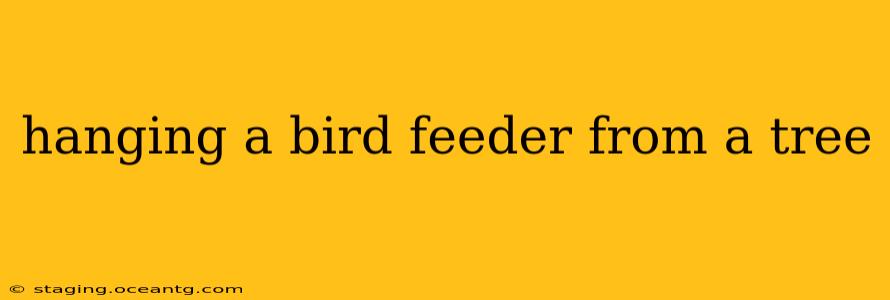Attracting feathered friends to your backyard is a rewarding experience, and hanging a bird feeder is a simple yet effective way to achieve this. However, ensuring the feeder is safely and effectively hung requires careful consideration. This comprehensive guide will walk you through the process, addressing common questions and concerns.
What type of tree is best for hanging a bird feeder?
The ideal tree for a bird feeder is a sturdy, mature tree with strong branches capable of supporting the weight of the feeder, especially when full of seed or suet. Avoid trees with weak or brittle branches, as these pose a risk of the feeder falling. Deciduous trees (those that lose their leaves in the fall) are often a good choice, providing shade in the summer and allowing sunlight in the winter. Consider the height – you want a location that's accessible for filling and cleaning, but high enough to deter cats and other predators.
How high should I hang a bird feeder?
The optimal height for a bird feeder is generally between 4 and 6 feet off the ground. This height provides a balance between accessibility for birds and protection from ground predators like cats and raccoons. Hanging it too low increases the risk of predation, while hanging it too high can make it difficult for smaller birds to reach and could make filling and cleaning more challenging.
What is the best way to hang a bird feeder from a tree?
There are several methods for hanging a bird feeder from a tree, each with its own advantages and disadvantages:
-
Using a hook: This is a simple and common method. Use a strong, heavy-duty hook designed for outdoor use, ensuring it’s securely attached to a sturdy branch. Avoid using flimsy hooks that could bend or break under the weight of the feeder.
-
Using a wire or rope: Securely fasten sturdy wire or rope around a branch, creating a loop to hang the feeder. Ensure the wire or rope is thick enough and securely tied to prevent slippage or breakage. Consider using a protective sleeve around the branch to prevent damage from the wire or rope.
-
Using a specialized bird feeder hanger: Many commercially available bird feeder hangers are designed to easily attach to branches and provide a secure and adjustable hanging system. These often feature clamps or straps that minimize damage to the tree.
What are some tips for hanging a bird feeder safely?
-
Choose a sturdy branch: Select a branch that is thick, strong, and capable of supporting the weight of the feeder. Inspect the branch for any signs of rot or weakness before hanging the feeder.
-
Use appropriate hardware: Employ high-quality hooks, wires, or ropes designed for outdoor use. Avoid using materials that could rust or deteriorate quickly.
-
Protect the tree: Consider using a protective sleeve or wrap around the branch to prevent damage from the hanging hardware.
-
Regularly check the feeder: Inspect the feeder and its hanging mechanism regularly to ensure everything is secure and in good condition. Repair or replace any damaged components immediately.
-
Consider wildlife: Be mindful of other wildlife that may be attracted to the feeder, such as squirrels or raccoons. Choose a feeder design that helps to deter unwanted guests or consider using deterrents.
Can I hang a bird feeder from a thin branch?
No, hanging a bird feeder from a thin branch is not recommended. A thin branch is likely to break under the weight of the feeder, especially when it is full of seed. This could result in the feeder falling and potentially causing damage or injury. Always choose a thick, sturdy branch capable of supporting the weight.
How do I keep squirrels from getting into my bird feeder?
Squirrels are notorious for raiding bird feeders. Several strategies can help deter them:
-
Squirrel-resistant feeders: These feeders have specialized designs that make it difficult for squirrels to access the food.
-
Baileys' cages: These cages surround the feeder, preventing squirrels from reaching it while allowing birds to access the food.
-
Slippery poles: Attaching a slippery pole to the feeder stand makes it difficult for squirrels to climb up.
By following these tips and selecting the right location and hanging method, you can create a safe and welcoming environment for your feathered friends, enjoying the beauty and activity they bring to your backyard. Remember that regular maintenance and careful observation are key to successful bird feeding.
